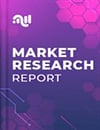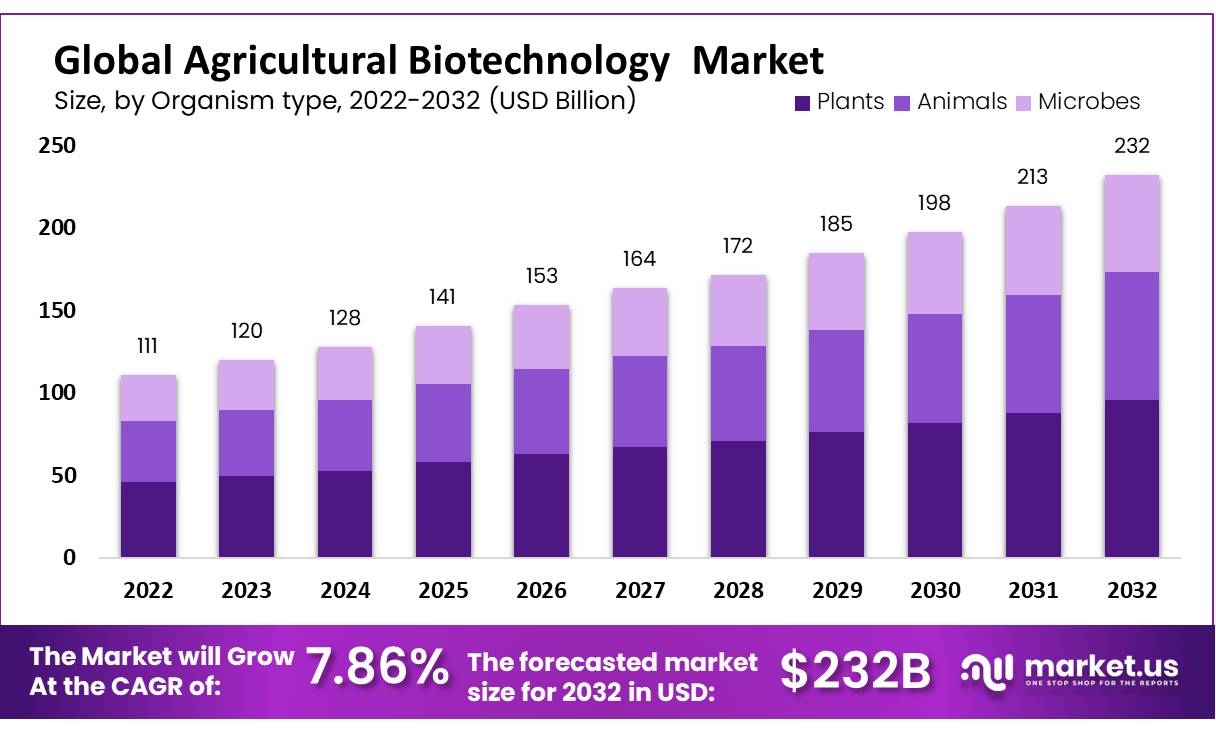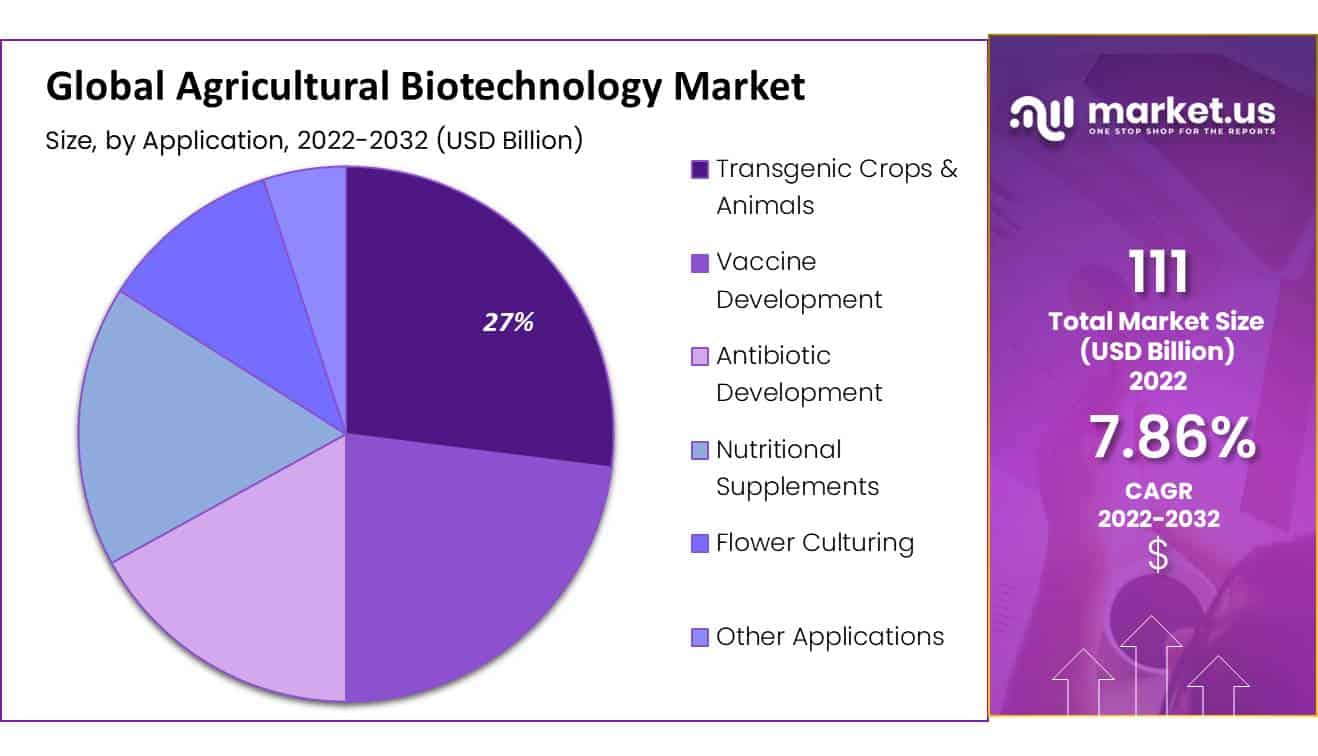Global Agricultural Biotechnology Market By Organism Type (Plants, Animals, Microbes), By Application (Vaccine Development, Transgenic Crops & Animals, Antibiotic Development, Nutritional Supplements, Flower Culturing, Biofuels, and Other Applications) By Region and Companies - Industry Segment Outlook, Market Assessment, Competition Scenario, Trends, and Forecast 2023-2032
- Published date: Oct 2023
- Report ID: 37333
- Number of Pages: 251
- Format:
- keyboard_arrow_up
Quick Navigation
Report Overview
In 2022, the global agricultural biotechnology market was valued at US$ 111 billion and is expected to reach around US$ 232 Billion by 2032. Between 2023 and 2032, this market is estimated to register the highest CAGR of 7.86%.
Agricultural biotechnology is a field of agriculture that uses scientific tools and processes to improve plant yield. To increase crop production, agricultural biotechnology is used. It is a set of scientific techniques and methods applied to plants and other living organisms. Crops altered in some way are genetically modified or transgenic crops. Demand for innovative breeding techniques is anticipated to surge in the market.
This is due to the increased penetration of biotechnological tools to invent or modify organisms’ traits, including animals, plants, and microbes, in response to yield, color, or size. Biotechnology tools are getting significant demand in agricultural applications. These involve tissue culture and micro propagation, market-assisted selection or molecular breeding, genetically modified crops and genetic engineering, conventional plant breeding and molecular diagnostic technologies.

Key Takeaways
- The agricultural biotechnology market size is expected to reach USD 232 billion in revenues by 2032.
- This growth will occur at a CAGR of 7.86% from 2023 to 2032.
- Genetic modification of crops leads to increased nutrient content, better food processing, resistance to pests and diseases, higher yields, nitrogen fixation, and resilience to harsh weather.
- In 2022, the global agricultural biotechnology market generated approximately USD 111 billion in revenue.
- Agritech is the use of scientific tools to improve plant yields. Genetically modified or transgenic crops have altered characteristics.
- Innovative breeding techniques are in demand.
- Plant organisms dominate the market in terms of revenue.
- Transgenic crops and animals are the most revenue-generating application.
- North America holds the largest market share at 35.3%.
- Asia Pacific is expected to be the second-largest market.
- Biotechnology tools are widely used in agriculture.
- Factors driving market growth include the rise of genetically modified crops, high demand for sustainable crops, and marker-assisted breeding.
- The increasing global population leads to higher food demand and the need for organic fertilizers.
- Market growth is hampered by the high cost of biotechnology products and uncertainty about their environmental and health effects.
- Key players in the agricultural biotechnology market include ADAMA
- Agricultural Solutions Ltd., BASF SE, Bayer AG, and others.
- Lavie Bio Ltd. aims to improve food quality and sustainability through microbiological-based products.
Organism Type Analysis
Based on organism type, the market for agricultural biotechnology is segmented into plants, animals, microbes, and others. Among these types, the plant segment is the most lucrative in the global agricultural biotechnology market. Plants are widely used in agricultural biotechnology to generate a high yield. Plants resistant to various viruses and diseases are used to improve overall productivity.
Due to genetically modified plants and controlled genetic changes produced in the organism, genetic engineering plays an essential role in agricultural biotechnology. Also, the transfer of a gene from one species to another species to generate more output is enabled by genetic modification. To increase crop potential genetic engineering is widely used on new crops.
Application Analysis
Based on application, the market is segmented into vaccine development, transgenic crops & animals, flower culturing, antibiotic development, biofuels, nutritional supplements, and other applications. Among these, the transgenic crops & animals segment holds the largest revenue share. Agricultural biotechnology has helped improve animals and crops by using modern technologies. A few applications of agricultural biotechnology are tissue culture, micro propagation, embryo transfer, cloning, and artificial insemination.
Effective use of biotechnological technology is micro propagation of disease-free plants, enhancing aluminum tolerance, genetic alteration of crops, and agricultural fortification. In addition, transgenic animals have advantages like enhanced prolificacy and reproductive performance, increased feed utilization, and growth rate, along with improved carcass composition, milk products, and composition. These factors hold a larger share and surge the application of biotechnology in the agriculture sector.

Key Market Segments
By Organism Type
- Plants
- Animals
- Microbes
By Application
- Vaccine Development
- Transgenic Crops & Animals
- Antibiotic Development
- Nutritional Supplements
- Flower Culturing
- Biofuels
- Other Applications
Drivers
Rising genetically modified crops globally
Increasing genetically modified crops drive market growth during the forecast period. Genetic modification allows the growth of crops with high nutrient content, increased food processing characteristics, increased resistance to pest control and diseases, more yield, nitrogen fixation, and improved strength to hold high climatic conditions. As a result, the genetic food market is surging and is estimated to boost the market’s growth.
High demand and increased sustainability of crops
Genetically modified plants are getting highly adopted due to high demand in the market and increased sustainability of crops. The International Service for the Acquisition of Agri-Biotech Application (ISAAA) estimates that almost 2.14 billion hectares of biotechnological crops were commercially developed.
These include biotechnology cotton, soybean, and biotechnology canola totaling 0.13 billion hectares. This factor is expected to help market expansion during the forecast period. As a result, key players are focusing on their product portfolio to get more attention and sustain in the market.
Restraints
Market growth is hampered due to high cost
The high cost of developing agricultural products is one of the major factors that hamper the market growth. In addition, increasing costs may be passed on to farmers from manufacturers, hampers the adoption of agricultural biotechnology products during the forecast period.
Growing Effects on Human Health
The application of biotechnology is relatively recent. Hence, it is challenging to anticipate its potential effects on health and the environment. There are many perspectives on this issue because experts are unaware of the health effects of genetically modified products.
For example, in genetic engineering, antibiotic-resistance genes serve as markers. If these genes are added to a plant’s genome, antibiotics might be less effective. In addition, pathogens can acquire resistance genes, increasing their drug resistance. It is anticipated that these uncertainties and risks will hamper the expansion of agricultural biotech market.
Opportunity
Use of Agriculture Biotech for Marker-assisted Breeding
Animal and plant development has been controlled for agricultural interests for the past thousand years. Selective breeding is a lengthy and imprecise procedure for creating a new crop variety. The addition of jet fuel by novel molecular approaches has boosted the selective breeding tank. In this procedure, plant breeding operations are guided, supported, and accelerated by DNA markers.
MAS facilitates a precis deal than traditional approaches as it relies on genome sequencing and sophisticated bioinformatics techniques to find markers. All these aspects will boost the agricultural biotech market size in the coming years.
Trends
Increasing Demand for Food due to the Growing Population
The growing population drives the demand for food, which further drives the demand for organic fertilizer. APAC region has the highest population of more than 50% of the worldwide population. The regional market in APAC is driven by the adoption of excellent cultivation techniques and agricultural practices during the forecast period.
Rapid urbanization also boosts the organic fertilizers market by reducing cultivable land, raising food shortage, and increasing demand for grains, pulses, vegetables, and other agricultural yields.
Regional Analysis
North America dominates the market due to its wide range of agro-climatic zones and crops, with an extensive global genetically modified planted area. US and Canada in this region represent about 50% of the global GM area and about 10% global planted area. North America is considered a net exporter of agricultural products with about 30% production.
Asia Pacific is expected to grow faster during the forecast period. This region is characterized by several political and economic systems, cultural backgrounds, and languages—the agricultural industry changed from adopting high technical standards in Japan to basic systems in India.

Key Regions
- North America
- The US
- Canada
- Mexico
- Western Europe
- Germany
- France
- The UK
- Spain
- Italy
- Portugal
- Ireland
- Austria
- Switzerland
- Benelux
- Nordic
- Rest of Western Europe
- Eastern Europe
- Russia
- Poland
- The Czech Republic
- Greece
- Rest of Eastern Europe
- APAC
- China
- Japan
- South Korea
- India
- Australia & New Zealand
- Indonesia
- Malaysia
- Philippines
- Singapore
- Thailand
- Vietnam
- Rest of APAC
- Latin America
- Brazil
- Colombia
- Chile
- Argentina
- Costa Rica
- Rest of Latin America
- Middle East & Africa
- Algeria
- Egypt
- Israel
- Kuwait
- Nigeria
- Saudi Arabia
- South Africa
- Turkey
- United Arab Emirates
- Rest of MEA
Key Players Analysis
The emerging key players focus on various strategic policies to develop their businesses in foreign markets. For example, several agricultural biotechnology market companies are concentrating on expanding their existing operations and R & D facilities. Also, businesses in this market are developing new products and portfolio expansion strategies through investments, mergers, and acquisitions. In addition, several key players are now focusing on different marketing strategies, such as spreading awareness about natural ingredients and boosting market growth.
Market Key Players
With many local and regional players’ presence, the agricultural biotechnology market is fragmented. As a result, market players are subject to intense competition from top players, particularly those with strong brand recognition and high distribution networks. As a result, companies have gained various expansion strategies, such as partnerships and product launches, to stay on top of the market. The following are some of the major players in the Global agricultural biotechnology Market industry:
- ADAMA Agricultural Solutions Ltd.
- BASF SE
- Bayer AG
- Benson Hill Inc.
- Certis USA LLC
- Corteva, Inc.
- DuPont de Nemours, Inc.
- Eurofins Scientific SE
- Evogene Ltd.
- Isagro SPA
- KWS SAAT SE & Co. KGaA
- Marrone Bio Innovations, Inc.
- Novozymes A/S
- Performance Plants Inc.
- Syngenta AG
- Vilmorin & Cie S.A
- Yield10 Bioscience, Inc.
- Other Key Players
Recent Developments
- In May 2022: Leading agricultural-biological company Lavie Bio Ltd, a subsidiary of Evogene Ltd., aims to improve the quality of food, sustainability and agricultural productivity by introducing microbiological-based- based products, revealed that for the 2022 season currently in preparation, Lavie Bio successfully in production and sold its decided yield to U.S. customers, Lavie Bio’s latest released bio-inoculant yield for spring wheat.
- In April 2022: KWS joined the DKE data agri router consortium. The forming of networks and the trade and combined use of data are essential lifters for tapping the strength of agricultural digitalization. DKE data drives this forward by getting together international companies and their digital services in the agricultural value chain with the exchange of data platform agrirouter. Also, digital consulting platform myKWS is forming network with seed producer KWS.
Report Scope
Report Features Description Market Value (2022) US$ 111 Bn Forecast Revenue (2032) US$ 232 Bn CAGR (2023-2032) 7.86% Base Year for Estimation 2022 Historic Period 2016-2022 Forecast Period 2023-2032 Report Coverage Revenue Forecast, Market Dynamics, COVID-19 Impact, Competitive Landscape, Recent Developments Segments Covered By Organism Type- Plants, Animals, Microbes; By Application – Vaccine Development, Transgenic Crops & Animals, Antibiotic Development, Nutritional Supplements, Flower Culturing, Biofuels, and Other Applications Regional Analysis North America – The US, Canada, & Mexico; Western Europe – Germany, France, The UK, Spain, Italy, Portugal, Ireland, Austria, Switzerland, Benelux, Nordic, & Rest of Western Europe; Eastern Europe – Russia, Poland, The Czech Republic, Greece, & Rest of Eastern Europe; APAC – China, Japan, South Korea, India, Australia & New Zealand, Indonesia, Malaysia, Philippines, Singapore, Thailand, Vietnam, & Rest of APAC; Latin America – Brazil, Colombia, Chile, Argentina, Costa Rica, & Rest of Latin America; the Middle East & Africa – Algeria, Egypt, Israel, Kuwait, Nigeria, Saudi Arabia, South Africa, Turkey, United Arab Emirates, & Rest of MEA Competitive Landscape ADAMA Agricultural Solutions Ltd., BASF SE, Bayer AG, Benson Hill Inc., Certis USA LLC, Corteva, Inc., DuPont de Nemours, Inc., Eurofins Scientific SE, Evogene Ltd., Isagro SPA, KWS SAAT SE & Co. KGaA, Marrone Bio Innovations, Inc., Novozymes A/S, Performance Plants Inc., Syngenta AG, Vilmorin & Cie S.A, Yield10 Bioscience, Inc., and Other Key Players Customization Scope Customization for segments, region/country-level will be provided. Moreover, additional customization can be done based on the requirements. Purchase Options We have three licenses to opt for: Single User License, Multi-User License (Up to 5 Users), Corporate Use License (Unlimited User and Printable PDF) Frequently Asked Questions (FAQ)
What is the growth rate of the agricultural biotechnology market?Between 2023 and 2032, this market is estimated to register the highest CAGR of 7.86%.
What is the current market value for agricultural biotechnology market?In 2022, the global agricultural biotechnology market was valued at US$ 111 billion.
Who are the key companies in the Global Agricultural Biotechnology Market?Key companies in the Global Agricultural Biotechnology Market include ADAMA Agricultural Solutions Ltd., BASF SE, Bayer AG, Benson Hill Inc., Certis USA LLC, Corteva, Inc., DuPont de Nemours, Inc., Eurofins Scientific SE and Isagro SPA
 Agricultural Biotechnology MarketPublished date: Oct 2023add_shopping_cartBuy Now get_appDownload Sample
Agricultural Biotechnology MarketPublished date: Oct 2023add_shopping_cartBuy Now get_appDownload Sample - ADAMA Agricultural Solutions Ltd.
- BASF SE Company Profile
- Bayer AG Company Profile
- Benson Hill Inc.
- Certis USA LLC
- Corteva, Inc.
- DuPont de Nemours, Inc.
- Eurofins Scientific SE
- Evogene Ltd.
- Isagro SPA
- KWS SAAT SE & Co. KGaA
- Marrone Bio Innovations, Inc.
- Novozymes A/S
- Performance Plants Inc.
- Syngenta AG
- Vilmorin & Cie S.A
- Yield10 Bioscience, Inc.
- Other Key Players
- settingsSettings
Our Clients
| Single User $4,599 $3,499 USD / per unit save 24% | Multi User $5,999 $4,299 USD / per unit save 28% | Corporate User $7,299 $4,999 USD / per unit save 32% | |
|---|---|---|---|
| e-Access | |||
| Report Library Access | |||
| Data Set (Excel) | |||
| Company Profile Library Access | |||
| Interactive Dashboard | |||
| Free Custumization | No | up to 10 hrs work | up to 30 hrs work |
| Accessibility | 1 User | 2-5 User | Unlimited |
| Analyst Support | up to 20 hrs | up to 40 hrs | up to 50 hrs |
| Benefit | Up to 20% off on next purchase | Up to 25% off on next purchase | Up to 30% off on next purchase |
| Buy Now ($ 3,499) | Buy Now ($ 4,299) | Buy Now ($ 4,999) |












